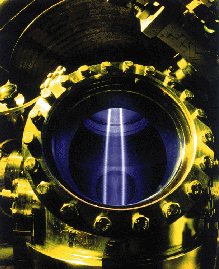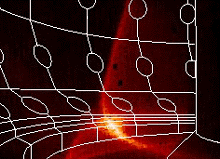
PLASMA ETCHING is used to fabricate high-density integrated
circuits. A microscopic blowup of the etched surface is shown in the upper
right.
can cause withering problems for plasma applications in other settings: When high-energy particles hurtle from hot fusion plasmas, they can knock cold particles loose from the container's walls, quenching and contaminating the plasma within.

ELECTRON CYCLOTRON RESONANCE plasma reactors are used to deposit
silicon dioxide and silicon nitride. Precise control of the deposited materials'
properties is achieved by varying the parameters of the plasma. [Courtesy
of Engineering Research Center for Plasma Aided Manufacturing, University
of Wisconsin, Madison; Photographer, Bruce Fritz]
![]()
Collective effects become still more interesting when the subject is waves
in plasma. In this respect, a neutral gas is a bit of a one-trick pony,
PLASMA SPRAY TORCHES are used to deposit thermal barrier layers
on jet engine components. [Courtesy of General Electric Co., Aircraft Engines
Division]
supporting only sound waves, which arise out of a seesaw competition between
the neutral atoms' pressure and their inertia when the gas is jostled at
the right frequency. Such a sound wave eventually dies away as collisions
between atoms turn its coherent motions into random, thermal energy in the
gas.
By contrast, a plasma supports a multitude of wave motions, the two simplest being so-called Langmuir waves and ion-sound waves. In Langmuir waves, the ions are nearly stationary and the electrons rapidly oscillate around them like pendulums. The force that swings the electrons back and forth isn't gravity, however, but the strong electric field that temporarily builds up when the negative charge in the local cloud, or "fluid," of electrons doesn't balance the positive charge in the ions. Hence the oscillations, as the disturbed electrons rush back to short out the field, overshoot, and rush back again. The lower-frequency ion-sound waves behave something like the usual waves in neutral gas, with one crucial twist: The waves' speed is now determined by the ion's inertia and the combined pressure of both species. In this wave, the ions and electrons swing in synchrony, tethered together by the electric field that comes about

EDGE PLASMA of a fusion experiment in the D-IIID tokamak controls
impurities and deposits heat on selected areas of the vessel's wall. [Courtesy
of General Atomics]